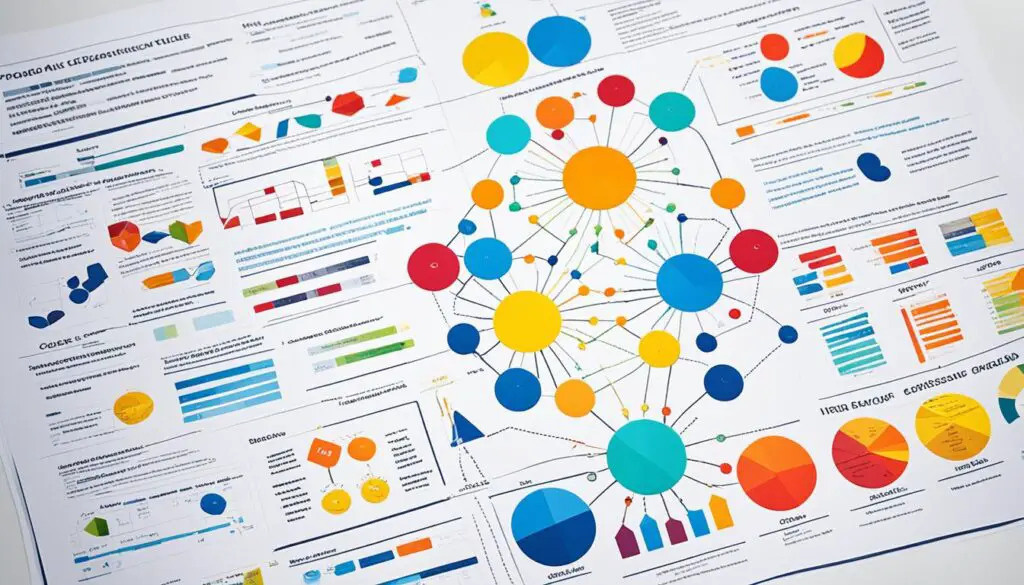Welcome to the realm of experimental research and qualitative data understanding. As a researcher, I know how crucial it is to look at qualitative data. This kind of data includes opinions from customers, survey data, or feedback from interviews. It helps us get a better handle on what we’re studying.
So, how do we analyze this kind of data? There are many methods. Each one helps us see the data in a new light. For example, content analysis lets us spot trends in what people say. Narrative analysis is all about stories. It helps us understand the personal experiences behind the data.
Discourse analysis focuses on how people talk. Thematic analysis helps us see what comes up again and again in the data. And grounded theory generates new ideas from the information you have.

Key Takeaways:
- Qualitative data analysis turns non-numerical data into useful insights.
- Different methods like content and thematic analysis help us deeply understand the data.
- Each way has its own advantages and challenges. The best way to go depends on several factors.
- Looking at qualitative data sheds light on the topic. It also gives a richer, detailed view of what people think.
- These methods can help businesses grow and make better products.
5 Qualitative Data Analysis Methods
Qualitative data analysis has several methods researchers can use. Each method has a new way of looking at data. This helps them find insights and understand better. Here are the five methods often used:
- Content Analysis: This method organizes and codes text or images. It helps find patterns, themes, or trends. By studying certain words, phrases, or pictures, researchers learn their deep meanings in a specific context.
- Narrative Analysis: Stories and personal experiences are the focus here. Researchers look at how people tell their stories and what they mean. They uncover themes, feelings, and cultural impacts through these stories.
- Discourse Analysis: This method looks at broader social and cultural influences on communication. By studying how language is used, power roles, and social settings, researchers understand how we create and share meaning.
- Thematic Analysis: Thematic analysis finds common themes or structures in data. It identifies and studies recurrent topics or ideas. This way, researchers gain insights into the experiences, views, and ideas of the people they study.
- Grounded Theory Analysis: This method uses data to shape theories. It’s about understanding a key phenomenon deeply. By directly using data, researchers can develop accurate theories based on real evidence.
Researchers select and apply these methods based on their research goals. This selection helps them find important insights. These insights contribute to a better understanding of the research topic.

Conclusion
Looking at qualitative data is key in experimental research. It uses different methods to dig deep. Content analysis, narrative analysis, discourse analysis, thematic analysis, and grounded theory help make sense of the data. This means that researchers can learn a lot, improve their work, and find new chances to grow.
Working with tons of data and making sure it’s reliable is hard. But, using these qualitative methods is worth it. It helps researchers use their data fully. So, they can make smart choices. And this is a big part of making products better and giving users a good experience.
These methods let researchers really understand their data. They bring out patterns and meanings. They show what people think and feel. This deep look at data helps in all kinds of work and research.
So, understanding qualitative data is crucial. It helps researchers get rich insights and understand their data better. This leads to making choices that are backed by data. Using these methods can bring new ideas, improve what we offer, and make users happier.
FAQ
What is qualitative data analysis?
Qualitative data analysis turns words, like feedback or interviews, into useful insights. These insights help experiments and research.
What methods are available for analyzing qualitative data?
Many methods are there for qualitative data. These include content analysis, narrative and discourse analysis, thematic analysis, and grounded theory.
What is content analysis?
Content analysis looks for patterns and themes in text. It helps researchers understand the data better.
What is narrative analysis?
Narrative analysis looks at stories to find deeper meanings in the data.
What is discourse analysis?
Discourse analysis studies how and where language is used. It helps gain insights from the data.
What is thematic analysis?
Thematic analysis finds patterns and themes in the data. This helps interpret the data in a structured way.
What is grounded theory analysis?
Grounded theory tries to come up with new theories from the data. It helps find fresh insights.
How do I choose the right method for analyzing qualitative data?
To choose the best method, consider your research questions, the type of data, and your situation. This includes your expertise and resources.
What are the benefits of analyzing qualitative data?
Analyzing this type of data offers deep understanding and flexibility. It also helps understand the context well and amplifies what participants say.
Is analyzing qualitative data time-intensive?
Yes, working with qualitative data takes time. But it’s worth it as it leads to valuable insights. These can help grow products and enhance user experiences.






